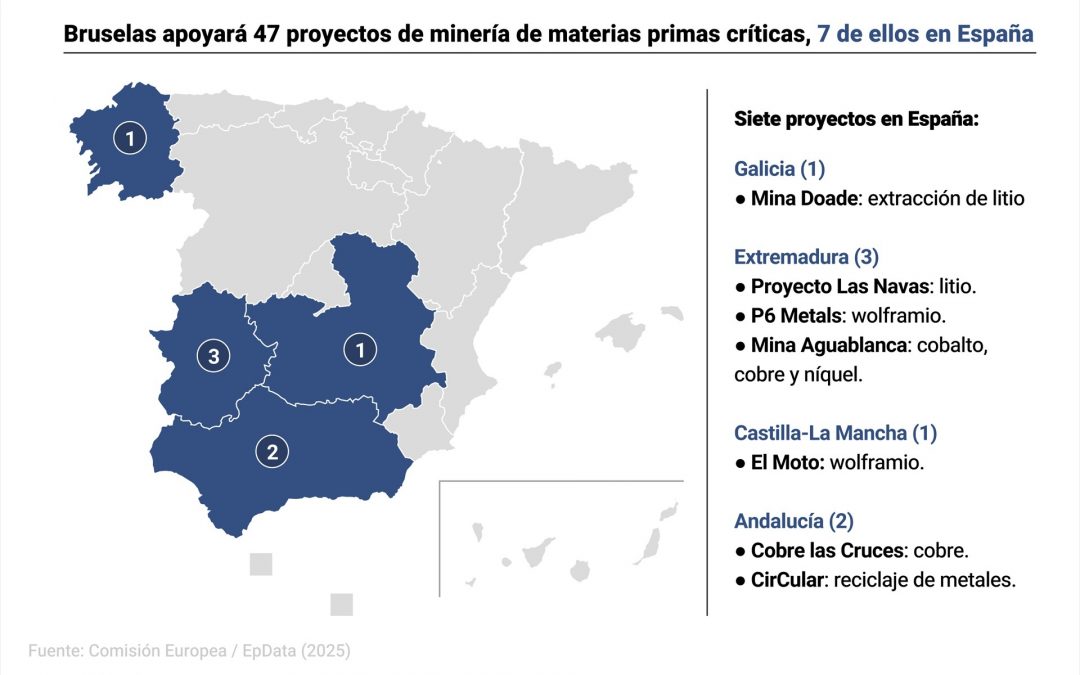Brussels – The European Commission will support 47 strategic projects for the exploitation of critical raw materials in the territory of the European Union, of which 7 are in Spain.
The aim of this initiative is to improve supply, reduce dependence on countries such as China, and strengthen the value chain of European raw materials.
The list drawn up by Brussels includes mining projects in 13 member states of the bloc, covering 14 critical materials out of the 17 it set as priorities in its directive.
Of the total identified projects, 22 initiatives focus on lithium, 12 on nickel, 11 on graphite, with another 10 related to cobalt and 7 on manganese, key elements for the automotive industry and electric batteries.
Most of Spain’s projects are related to mineral extraction. Specifically, it identifies Mina Doade, Galicia, and the Las Navas mining project, Extremadura, for lithium extraction; P6 Metals, Extremadura, for tungsten extraction and processing; and the El Moto mining project, Castilla-La Mancha, also focused on tungsten.
Other priority operations in Spanish territory include the copper extraction and processing initiative of Cobre las Cruces, Andalusia; the Aguablanca mine for cobalt, copper, and nickel supply in Extremadura; and the CirCular mining recycling project, based in Andalusia, to contribute to the supply of copper, nickel, and platinum metals.
At a press conference from the EU capital, the European Commission’s Vice President of Industrial Strategy, Stéphane Sejourne, defended that without critical raw materials “there can be no decarbonization,” pointing out that domestic production is key to prevent the EU from diversifying its supplies and not moving from dependence on Russian hydrocarbons to Chinese raw materials.
“To prevent Chinese lithium from becoming tomorrow’s Russian gas, the European Union has established a legislative framework to avoid this dependence, and now we must extract more and open more mines in Europe,” Sejourne asserted, proposing to “consolidate the European value chain of critical materials” to achieve the objectives set for 2030.
In any case, the French commissioner acknowledged that there is “political work” ahead to ensure that mining is “socially acceptable,” noting that political leaders must educate and deepen the narrative of national and European general interest. “We have to do a bit of political work. This means being in contact with businesses, obviously, and with employees, but also with people,” he admitted.
Thus, the plan involves supporting different phases of the value chain, as out of all the identified projects, 25 include mineral extraction activities, while another 24 focus on material processing, 10 on recycling, and two on the substitution of critical raw materials.
This list of projects will benefit from the coordinated support of the Commission, member states, and financial institutions to promote their operational launch, given the estimated investment of around 22 billion euros needed to launch the projects. They will also benefit from simplified provisions for permits, aiming to ensure predictability for the initiative promoters.
Behind this list is the intention of the European Executive to guarantee the security of supply of the Union’s strategic raw materials. The projects were selected because they are “technically viable or have the potential to be so within a reasonable time, show expected production volumes, and are executed sustainably.” (March 25)
 go to the original language article
go to the original language article
